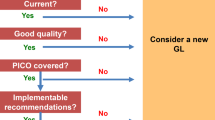Abstract
Prior to the evolution of evidence-based medicine, medical practice was largely based on personal experience and widely accepted, but unproven theories. This often resulted in negative patient outcomes, which led to an increasing awareness that a standardized method to guide clinical practice was needed. This led to the advent of the evidence-based model, which focuses on answering a clinical question. With the practice of evidence-based medicine also came the need to improve current processes in order to continually provide quality, patient-centered care, i.e., the model for improvement. While both evidence-based model and the model for improvement are often considered separately, they are arguably linked together. Once evidence-based knowledge is organized into a guideline, policy, or procedure, it must be implemented into practice. This is a very complex task and must take into account many factors that will guide success or failure. Some of these factors are the desire and capacity to change, a gap where implementing knowledge will lead to an improved outcome, as well as internal and external cultural influences. Using a quality improvement method, such as the model for improvement, will allow for small tests of change and adjustments that will lead to stabilization when new evidence is implemented. Sustaining change is the final step and will require transparent feedback and data as well as ongoing evaluation of new evidence to achieve the best possible outcome.
Access this chapter
Tax calculation will be finalised at checkout
Purchases are for personal use only
Similar content being viewed by others
References
Perry S. Book review: technology in the hospital: transforming patient care in the early twentieth century. N Engl J Med. 1996;334:128–9.
Zimerman AL. Evidence-based medicine: a short history of a modern medical movement. Am Med Assoc J Ethics. 2013;15(1):71–6.
Sackett DL, Rosenberg WM, Gray J, Haynes R, Richardson W. Evidence based medicine: what it is and what it isn't. BMJ. 1996;312(7023):71–2.
Fernandez A, Sturmberg J, Lukersmith S, Madden R, Torkfar G, Colagiuri R, Salvador-Carulla L. Evidence-based medicine: is it a bridge too far? Health Res Policy Syst. 2015;13(1):1–9.
White B. Making evidence-based medicine doable in everyday practice. Fam Pract Manag. 2004;11(2):51–8.
Langley GJ, Moen RD, Nolan KM, Nolan TW, Norman CL, Provost LP. The improvement guide: a practical approach to enhancing organizational performance. San Francisco, CA: Jossey-Bass; 2009.
Glasziou P, Ogrinc G, Goodman S. Can evidence-based medicine and clinical quality improvement learn from each other? BMJ Qual Saf. 2011;20:i13–7.
Shojania KG, Grimshaw JM. Evidence-based quality improvement: the state of the science. Health Aff. 2005;24(1):138–50.
McGlynn EA, Asch SM, Adams J, Keesey J, Hicks J, DeCristofaro A, et al. The quality of health care delivered to adults in the United States. N Engl J Med. 2003;348(26):2635–45.
Plsek P. Complexity and the Adoption of Innovation in Health Care. Accelerating Quality Improvement in Health Care Strategies to Speed the Diffusion of Evidence-Based Innovations. 2003 Jan [cited 2016 Feb 5] [18 pp]. Available from: http://www.nihcm-old.com/pdf/Plsek.pdf.
Irving A. Policies and Procedures for Healthcare Organizations: A Risk Management Perspective. PSQH [Internet]. 2014 Oct [cited 2016 Feb 5] [6 pages]. Available from: http://psqh.com/september-october-2014/policies-and-procedures-for-healthcare-organizations-a-risk-management-perspective.
Godfrey MM, Melin CN, Muething SE, Batalden PB, Nelson EC. Clinical microsystems, part 3. Transformation of two hospitals using microsystem, mesosystem, and macrosystem strategies. Jt Comm J Qual Patient Saf. 2008;34(10):591–603.
Solberg L, Brekke ML, Fazio CJ, Fowles J, Jacobsen DN, Kottke TE, et al. Lessons from experienced guideline implementers: attend to many factors and use multiple strategies. Jt Comm J Qual Patient Saf. 2000;26(4):171–88.
Berwick DM. Developing and testing changes in delivery of care. Ann Intern Med. 1998;128(8):651–6.
Institute of Medicine. Crossing the quality chasm. A new health system for the 21st century. Washington, DC: National Academy Press; 2001.
Brili RJ, Allen S, Davis JT. Revisiting the quality chasm. Pediatrics. 2014;133(5):763–5.
Parston G, McQueen J, Patel H, Keown OP, Fontana G, Kuwari HA, et al. The science and art of delivery: accelerating the diffusion of health care innovation. Health Aff. 2015;34(12):2160–6.
Berwick DM. Disseminating innovations in health care. JAMA. 2003;289(15):1969–75.
Jurecko L. Lean Tools Help Prevent Hospital Acquired Infections. [Internet]. Children’s Hospital Association; 2015 [Updated July 20, 2015; cited Feb13, 2016]. Available from: https://www.childrenshospitals.org/newsroom/childrens-hospitals-today/summer-2015/articles/lean-tools-help-prevent-hospital-acquired-infections.
Lyng KM. From clinical practice guidelines, to clinical guidance in practice-Impacts for computerization. Int J Med Inform. 2013;82(12):e358–63.
Hsiao JL, Chen RF. Critical factors influencing physicians’ intention to use computerized clinical practice guidelines: an integrative model of activity theory and the technology acceptance model. BMC Med Inform Decis Mak. 2016;16(16):1–15.
Khullar D, Kocher R, Conway P, Rajkumar R. How 10 leading health systems pay their doctors. Healthcare. 2015;3(2):60–2.
Clarke N. Can a time bank beat physician burnout? Stanford thinks so. [Internet]. Advisory Board; 2015 [Updated September 30th, 2015; cited Feb 27, 2016]. Available from: https://www.advisory.com/research/medical-group-strategy-council/practice-notes/2015/september/stanford-time-bank-program.
Shojiana KG, Grimshaw JM. Evidence-based quality improvement: the state of the science. Health Aff. 2005;24(1):138–50.
Grimshaw JM, Shirran L, Thomas R, Mowatt G, Fraser C, Bero L, et al. changing provider behavior: an overview of systematic reviews of interventions. Med Care. 2001;39(8):II-2–II-45.
Bahm A, Freedman SB, Guan J, Guttman A. Evaluating the impact of clinical decision tools in pediatric acute gastroenteritis: a population-based cohort study. Acad Emerg Med. 2016;23(5):599–609.
Robeznieks A. Prospering by standardizing processes and improving the patient experience. [Intenet]. Modern Healthcare; 2014 [Updated Jan 11, 2014, cited March 9, 2016]. Available from: http://www.modernhealthcare.com/article/20140111/MAGAZINE/301119950.
Landi H. At Tacoma’s MultiCare, Leaders Pursue Core Patient Safety Improvement. [Internet]. Healthcare Informatics; 2016 [Updated March 14, 2016, cited March 19, 2016]. Available from: http://www.healthcare-informatics.com/article/tacoma-s-multicare-leaders-pursue-core-patient-safety-improvement.
Washington State Bree Collaborative. [Internet]. [Cited September 4, 2016]. Available from: http://www.breecollaborative.org.
Author information
Authors and Affiliations
Corresponding author
Editor information
Editors and Affiliations
Rights and permissions
Copyright information
© 2017 Springer International Publishing AG
About this chapter
Cite this chapter
Daniels, P.A., Capouya, J.D. (2017). Implementation of Evidence-Based Care. In: Dandoy, C., Hilden, J., Billett, A., Mueller, B. (eds) Patient Safety and Quality in Pediatric Hematology/Oncology and Stem Cell Transplantation. Springer, Cham. https://doi.org/10.1007/978-3-319-53790-0_9
Download citation
DOI: https://doi.org/10.1007/978-3-319-53790-0_9
Published:
Publisher Name: Springer, Cham
Print ISBN: 978-3-319-53788-7
Online ISBN: 978-3-319-53790-0
eBook Packages: MedicineMedicine (R0)




